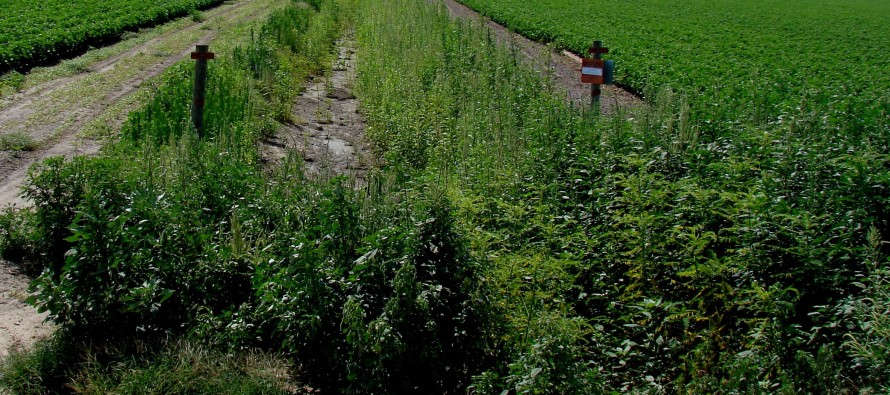Glyphosate-resistant Palmer Amaranth on Turnrows and Ditchbanks

One area of concern in glyphosate-resistant (GR) Palmer amaranth management is controlling this species on turnrows, field borders, and ditchbanks. Clean crop fields surrounded on turnrows and/or ditchbanks by GR Palmer amaranth is a common sight in areas where it is prevalent. Glyphosate-resistant Palmer amaranth has also colonized fallow areas, road sides, and construction sites. When GR Palmer amaranth in these areas is left uncontrolled, it produces seed which is often disseminated into adjacent fields.
Some options are available to manage GR Palmer amaranth along turnrows and ditchbanks. Unfortunately, none of these are foolproof. Turnrows and ditchbanks may be mowed or tilled to control GR Palmer amaranth. While these tactics are relatively effective, they must be performed repeatedly because they generally do not control all Palmer amaranth plants and those remaining will produce seed which can reinfest crop fields. Tillage, usually in the form of disking, is more effective than mowing for control of GR Palmer amaranth present at the time of the operation. However, disking will require multiple passes, is only effective on turnrows, and a disk is difficult to maneuver around pointed rows and power poles. A rotary mower is much easier to handle than a
disk, but it will not kill GR Palmer amaranth, so the turnrow and/or ditchbank must be mowed repeatedly to avoid seed production.
Many growers prefer to chemically control GR Palmer amaranth on turnrows and ditchbanks, but the legality of these herbicide applications is often unclear. Most herbicide labels restrict application to water, but they do not always specify whether application to a ditch with no water is allowed. Some labels, such as dicamba (Clarity) and triclopyr (Garlon, Remedy), specifically address applications to “non-crop†areas. However, “non-crop†area is not clearly defined on most labels.
Although the true definition of a turnrow is vague as it relates to herbicide applications and ditches fall into a number of categories, i.e., drainage, irrigation, non-flowing, some points are clear about herbicide applications to turnrows and ditchbanks. Gramoxone SL is not labeled for application to ditches. Glufosinate, when applied as Liberty 280 SL, is not labeled for application outside of crop fields. However, glufosinate as Rely 280 may be applied to “farmsteadsâ€, which the herbicide label defines as “non-crop areas around farmstead buildings, shelter belts, along fences, and general nonselective farmstead weed control.†Although dicamba and triclopyr are labeled for some turnrow and/or ditchbank applications, most crop species are sensitive to these herbicides.
Diquat (1 to 2 quarts per acre), which is a group 22 herbicide similar to Gramoxone SL, is labeled for application to non-crop areas as well as non-flooded ditches. Direx may be applied to uncultivated agriculture areas at a rate of 4 to 12 quarts per acre. Although Diquat has not been tested extensively for efficacy against GR Palmer amaranth, it is a non-selective, contact herbicide, so it should at least be effective on small GR Palmer amaranth. The combination of Diquat and Direx should control small, emerged GR Palmer amaranth and provide residual control if the application receives rainfall for incorporation.







Let me tell You a sad story ! There are no comments yet, but You can be first one to comment this article.
Write a comment